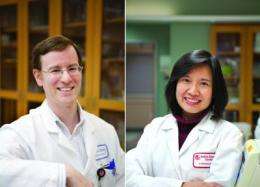Researchers identify pathways leading to activation of good fat

Researchers at the Joslin Diabetes Center have identified for the first time two molecular pathways that are critical to activating a type of "good" fat found in the body, a discovery that could play an important role in the fight against obesity and diabetes.
The fat, called brown fat, actually burns energy rather than storing it, which the more common white fat does.
The study, published in the October issue of Endocrinology, sought to learn more about how to get brown fat cells to grow. It identified two molecular pathways that lead to a protein called necdin that blocks brown fat growth.
With this information, researchers can look for ways to modify the steps along the pathways, either to stimulate another protein, called CREB, which shuts down necdin, or block a different protein called FoxO1, located along the second pathway, which stimulates necdin. The study showed for the first time that the two proteins can bind directly to the necdin gene.
"This is a very important piece of the puzzle," said Aaron Cypess, MD, PhD an assistant investigator and staff physician at Joslin and lead author of the paper. "It provides new opportunities. The point is that we have got to learn how to grow these brown fat cells. There's a lot of missing information. We filled in some of the important missing pieces."
Based on previous research, including a 2005 paper by Yu-Hua Tseng, Ph.D., a Joslin investigator who also is senior author of today's paper, there was some evidence that the two pathways were important to the process of brown fat growth.
In today's study, the researchers conducted tests in vitro on different cell lines derived from brown fat taken from mice. "We used different drugs to stimulate or block the signaling pathways that we thought were important," Dr. Cypess said. "The result was that we defined the two pathways. We found what goes to what to cause something to happen to the cells."
One pathway to necdin starts with insulin cells and runs through proteins called Ras and ERK1/2 before getting to CREB. The second also starts with insulin and runs through proteins called P13-K and Akt before getting to FoxO1.
"Both pathways get you there," Dr. Cypess said.
"With this more detailed description of the pathways leading to (brown fat tissue), there can be more focused attempts to develop interventions using brown fat as a treatment for obesity and diabetes," the paper concludes.
One intervention could be to grow brown fat in a laboratory and transplant it into the bodies of people who need it. Another could be the development of drugs to stimulate brown fat growth.
This is the latest in a series of studies on brown fat led by Drs. Cypess and Tseng. In July, Dr. Cypess and his team showed that brown fat can be seen on imaging studies in nearly half of all children and is most active in those who are thin. The amount of the fat also increases in children up until puberty, when it begins to decline, according to that study, published in the Journal of Pediatrics.
In 2009, Dr. Cypess and his team demonstrated in the New England Journal of Medicine for the first time that brown fat is metabolically active in adult humans. Previously, it had been thought that brown fat was present only in babies and children. The 2009 study showed it was found to be active under normal living conditions in 5.4 percent of all adults, with higher rates in women.
A 2008 Joslin study published in Nature by Dr. Tseng and colleagues discovered that a protein called BMP7 could induce brown fat formation. Another more recent 2011 study from Tseng's group identified precursor cells in mice that can be triggered by BMP7 and other inducers to transform into brown fat.
Concerning the small percentage of people in whom brown fat was detected in the 2009 imaging study, Tseng said it is possible that a much higher percentage of people have brown fat -- possibly everybody -- but that it simply was not able to be detected in the study because the scanners were not sensitive enough or because it might not have been activated in most people.
Either way, she said she considers the study of brown fat to be a "very important" issue because it offers a potential treatment for the obesity epidemic.
"Brown fat burns energy," she said. "It is a special tissue. These studies have opened up a new avenue for the treatment of obesity and its related disorders. This study will help us deepen our understanding of brown fat formation and could in the future combined with other information that we have learned be used to develop drugs or other interventions for obesity. But we still need to know more."





















